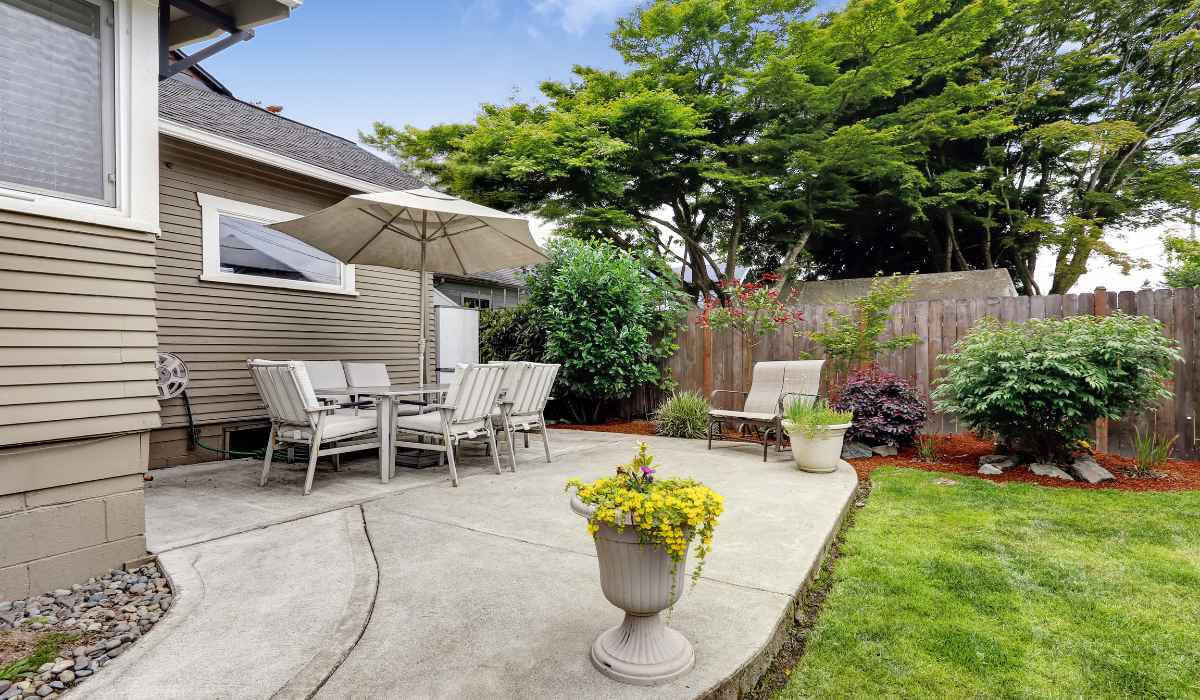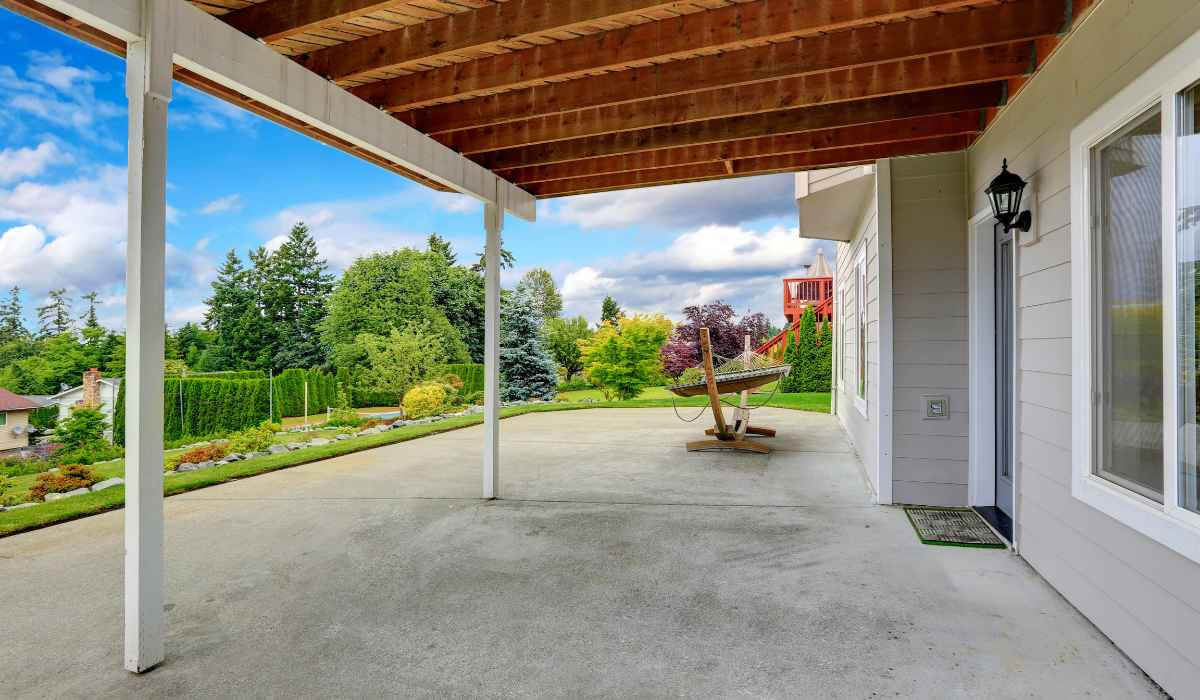Imagine a crisp evening, your loved ones gathered around a fire pit on your concrete patio, a warm glow painting a picture of serene bliss. But the harmony of this scene conceals a pertinent question - can this inviting fire wreak havoc on your pristine concrete?
The answer dances between yes and no, woven within the type of fire pit, its care, and protective measures.
Peel back the layers to understand the surprising fragility of concrete under the relentless dance of flames. A propane pit may be benign, but a wood-burning one could leave scars over time.
But don't fret! Simple solutions like heat-resistant mats or fire-resistant materials can redefine the game, preserving your concrete haven.
Join us as we unlock the formula for a harmonious balance between your fire pit's captivating warmth and the enduring charm of your patio.
If you have a patio with paving stone, bricks or other materials, we have another article that may also be of benefit.
Will a Fire Pit Ruin Concrete?
A fire pit can cause damage to concrete if not properly protected
Heat-resistant mats or pads can help to mitigate the impact on concrete
Installing fire-resistant materials and alternative location options are worth considering
Understanding the Composition and Heat Resistance of Concrete
Overview of What Concrete Is Made Of
Concrete is a versatile and robust material primarily composed of three main components: cement, water, and aggregates.
Aggregates comprise the largest portion and can be a combination of sand, gravel, crushed stone, or other materials.
Cement, usually made from limestone, acts as a binding agent when mixed with water, creating a paste that coats the aggregates and forms a solid structure as it hardens.
Heat Resistant Properties of Concrete
One of the key characteristics of concrete is its ability to resist heat and provide insulation, making it suitable for various applications.
The heat resistance of concrete can be attributed to the elements in its composition, such as the type of aggregate used.
For example, aggregates like limestone or quartz can provide higher fire resistance than other materials. Furthermore, the amount of moisture and unit weight can also impact concrete's ability to withstand high temperatures.
Generally, concrete is a good insulator and can maintain strength and stability under regular fire conditions, thanks to the thick mass that slows heat transfer.
Nevertheless, it is essential to understand that while concrete is heat resistant to a degree, it is not entirely fireproof.
How Extreme Heat Affects the Structural Integrity of Concrete
When exposed to extreme heat, concrete can undergo a process called "calcination." During this process, the cement paste and the aggregate materials can begin to break down, causing the concrete to become more brittle.
In addition, excessive heat can cause the moisture trapped within the concrete to turn into steam, creating internal pressure that can lead to fractures and spalling.
By selecting the appropriate materials, design, and precautions, you can ensure that your concrete is as heat resistant as possible, helping to maintain its integrity and structural performance under challenging conditions.
Fire Pits and Concrete: The Direct Impacts
Thermal Shock
Fire pits can sometimes damage concrete patios due to their high heat.
Prolonged exposure to very high temperatures can cause thermal shock, which happens when the outer layers of the concrete expand at a different rate than the inner layers.
This difference in expansion can cause cracks to form in the concrete.
Spalling
Another consequence of prolonged exposure to heat is spalling. Spalling occurs when moisture trapped inside the concrete turns to steam and tries to escape.
This can cause the surface of your concrete patio to flake, pop up, or peel off. Over time, this can lead to more severe damage and compromise the structural integrity of your patio.
Discolouration
High heat can also cause discolouration on concrete surfaces.
Concrete is generally quite heat-resistant, but continuous exposure to heat from a fire pit may develop darker, heat-stained areas on your patio.
This could affect the aesthetic appearance of your outdoor space.
Possible Conditions That Could Aggravate These Impacts
Several factors can contribute to the severity of the impacts discussed above. Here are some key factors that you should consider:
Fire Size: A larger fire generates more heat than a smaller one, increasing the risk of damage to your concrete patio.
Duration: A longer-lasting fire can increase the likelihood of concrete damage due to the extended period of high heat exposure.
Type of Firewood: Certain firewood types burn hotter than others. For example, hardwoods like oak and hickory produce more heat than softwoods like pine or cedar. Choosing wood with a lower heat output may help reduce potential damage to your patio.
Taking a few safety precautions is essential to minimise the risk of damage to your concrete patio.
These may include using a spark screen or lid to reduce ember spread, placing a heat retardant mat or fireproof barrier under your fire pit, and foregoing wood-burning fire pits in favour of propane fire pits, which produce less heat and no embers.
By being aware of the potential impacts of fire pits on concrete and understanding the factors that can aggravate these impacts, you can take the necessary steps to protect your patio and ensure its longevity.
Mitigating the Impact of Fire Pits on Concrete
Selecting the right location for your fire pit is crucial to prevent heat damage to your concrete patio.
Ensure you regularly inspect for any signs of damage or weak spots in the concrete that might be vulnerable to heat damage.
If you opt for a wood-burning fire pit, consider a spark screen to restrict the spread of embers and ash.
How to Use Heat-Resistant Barriers or Fire Pit Pads
To further protect your concrete from heat damage, consider using fireproof, heat-retardant mats or thermal barriers beneath your fire pit.
These products are designed to withstand high temperatures and shield the concrete surface from direct heat exposure.
Remember that you'll need different types of fire-resistant barriers for wood-burning and propane fire pits, so make sure to choose the right product for your specific fire pit.
The Role of Maintenance in Prolonging the Life of Your Concrete Surface
Regular maintenance and upkeep of your fire pit and surrounding concrete area are essential to prolong the life of your patio surface.
Prevent the formation of cracks and premature wear of your concrete slab by keeping it clean and debris-free.
Additionally, regularly inspect the fire pit for signs of rust, deterioration, or damage, which might cause heat and embers to directly impact the concrete.
Following these tips can help you enjoy your fire pit safely while minimising the impact on your concrete patio, allowing for a more pleasant and worry-free outdoor experience.
To Finish Up
A fire pit can indeed cause damage to your concrete patio over time.
The heat generated from wood-burning or even propane fire pits can lead to dehydration of the concrete, causing it to expand, crack, and even break down the cement in the mixture.
This can also lead to a change in colour, often resulting in a pinkish hue on the surface.
Final Thoughts on How to Best Use and Maintain a Fire Pit on Concrete
To ensure the safety and longevity of your fire pit and concrete patio, it's essential to take proper precautions. Here are some tips to best use and maintain a fire pit on concrete:
Use a heat retardant mat or barrier: Placing a fire-resistant mat or barrier beneath your fire pit can greatly reduce the chances of heat damage to your concrete surface.
Propane vs. wood burning: Propane fire pits tend to cause much less damage to concrete surfaces than wood-burning fire pits.
Keep it clean: It's important to regularly remove ash, debris, and combustible materials from your fire pit and surrounding area to prevent potential fire hazards.
Use a spark screen or lid: A spark screen or lid can keep your fire pit contained, avoiding potential mishaps from escaping embers.
Install thermal barriers: Consider installing thermal barriers on top of the concrete surface to help reduce heat transfer and protect the concrete from potential damage.
Your concrete patio is an investment you would like to protect and enjoy for years.
By taking these steps, you can help maintain its appearance and structural integrity while enjoying the warmth and ambience of your fire pit on those chilly evenings.
Frequently Asked Questions
What should be placed under a fire pit on concrete?
To protect your concrete surface from heat damage, it's advisable to place a heat-retardant mat or pad under your fire pit. These fire-resistant mats are designed to withstand high temperatures and prevent heat from damaging your concrete or wooden deck.
They are usually easy to set up and remove when not in use, making them a convenient option for protecting your patio. Heatproof mats are especially useful for above-ground fire pits.
Is it safe to build a fire pit on a concrete slab?
Building a fire pit on a concrete slab is safe if you use the right materials and precautions.
However, the high heat the fire pit generates can eventually damage the concrete. Knowing how to protect your concrete from heat is essential to maintaining its integrity and appearance.
What precautions should be taken for a permanent fire pit on concrete?
When planning to install a permanent fire pit on your concrete patio, you should take several precautions to ensure its long-term durability. First, inspect your concrete slab for signs of damage or weaknesses that may be vulnerable to heat. Move your fire pit away from existing damage to avoid exacerbating any issues.
Additionally, you can consider installing a protective layer of fire bricks, refractory cement, or a heat-retardant mat to serve as a barrier between the fire pit and the concrete surface. This will help shield the concrete from the high temperatures produced by the fire.
Subscribe to our email
Just enter your email address below to receive a monthly email with links to all the latest blog posts. Simple unsubscribe at any time.

